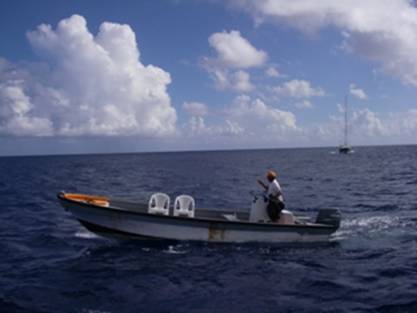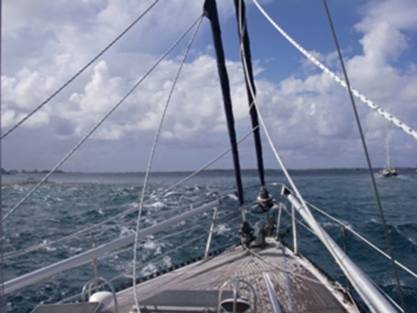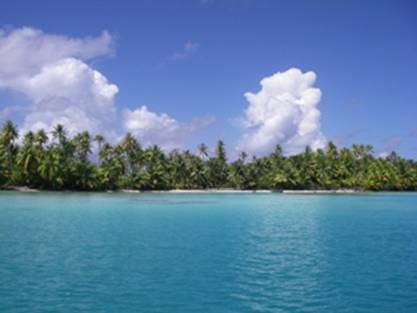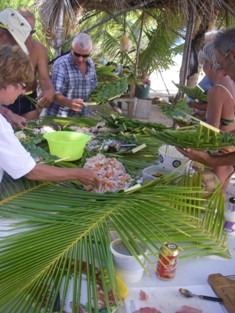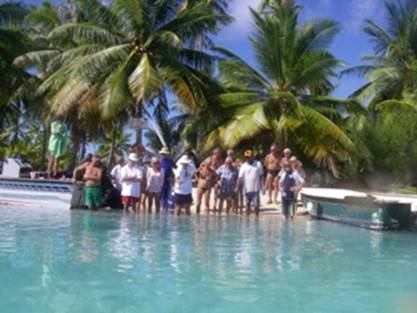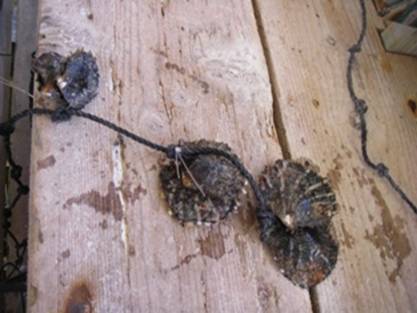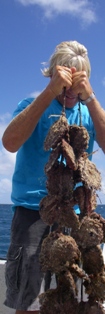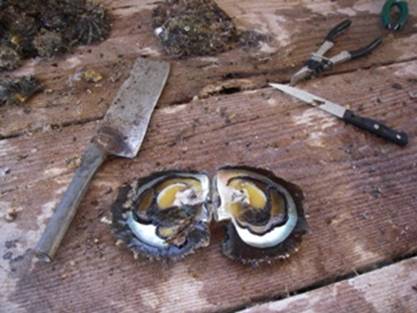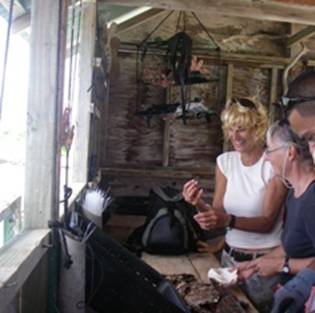BLUE WATER RALLY - TUAMOTUS - Manihi

|
14.27S 146.01W Tuesday 14th April and the first chance
I have had to update the blog. We arrived at Manihi Atoll with Zippy just beside us last Thursday at
around 1200 hrs – the outer length of the atoll is around 15 miles so it
took another couple of hours to sail to the only pass for a yacht to enter the
lagoon named Tairapa. Zippy only has one useable sail since the damage to
her boom and bimini which is being replaced in
Zippy, Billy one sail, beside us with damaged boom….. Stargazer and Rascal had arrived much earlier in the day and on
inspection decided to risk going through the pass without a pilot. They
had very little tide against them and motored through with no problem.
However, within the last few days three out of ten yachts have hit the reef so
we decided we would rather pay the 3,000 PF (about 15 pounds) to have a pilot
organised through Xavier by Zippy to assist us through. He came to meet us at 1500 hours, asking that Zippy take the lead as
her engine is much more powerful than ours. We needed to be motoring at a
minimum of six knots to counteract the powerful out flowing current which is
almost our limit. Well! David and Jennie literally made a charge for it,
with us following close behind and for me it was one of most scary sailing
experiences yet.
Fernand, our pilot, complete with arm chairs came to assist us through
Tairapa pass We were both cork screwing through the narrow passage where the reefs
were visible each side (it is just sixty meters wide), the wind blowing over
twenty knots on our starboard beam, the tide running out of the lagoon (against
us) at four and a half knots and the depth just half a meter below our keel in
places – imagine if you had engine failure at this moment – or
worse if Zippy just in front did!!
Anahi in Tairapa pass, Zippy ahead to our right, boiling seas, little
depth and the reef visible just to the right….
And cork screwing through the narrow pass…. Flat out we were only making about two knots – but after a hair
raising few minutes we were through and ‘inside’ the atoll, still
coral heads were everywhere – so to be piloted through the maze to our
anchoring position with the others was worth every single last penny.
Inside the lagoon! Just like open sea with a little ‘dez
rez’ plumb in the middle! You cannot imagine until you have actually visited these places
yourself how utterly different they are to one another. Here, the
‘necklace’ of little islands, motus, are strung in a huge circle
ten by fifteen miles across. Motus are inherited from family members but
it is possible to buy one with full title – this is what Xavier
did. He is a Frenchman who was Commander in Chief of the French navy in
Polynesian waters for many years. Now retired, his project has been to
set up a ‘sailmail’ internet station and what a project it has been
over the past two years. He has a solar powered battery bank with over 36
thousand amp hours at his small wooden outpost which trebles up as a house,
office and sub station.
Xavier on his private jetty
Xavier’s ‘motu’ with a little signpost depicting
‘miles to Thursday evening we just tuckered up for the night with nine other BWR
yachts beside us. Big Blue had organised fresh French bread for us baked
by Fernand.
Arriving at the anchorage and dropping anchor…… Friday morning we were all collected by Fernand, he is a Tahitian fisherman
now settled here with his brother and family, and taken by speed boat (more
like a bread board with white plastic chairs) on a forty minute white knuckle
ride to their motus where we could swim safely in the lagoon. Margaret on
Our Island was on a similar boat two days before, travelling at speed, when the
steering cable snapped and some of the passengers were thrown out of the boat,
she had to go to ‘hospital’ to receive three or four stitches in
her leg and the others were pretty shocked and bruised too.
Fernand coming to collect us for our beach and lagoon trip…. The bays around the edge of the lagoon are the stuff of dreams with
crystal clear turquoise waters, a myriad of colourful fish swimming, coconut
palms and coral beaches.
Beautiful sheltered lagoons of Fernand’s motu…
Stuff of dreams…….. We all swam before heading off to another inlet where lunch was being
prepared by Fernand’s family and friends; his brother Ricky joined us and
took those that wanted to go spear fishing for our lunch. Everybody had
brought bread, salads, chutney, cheese, salamis and cold drinks to share
– our rum was a surprise success in the fresh coconuts – and we all
settled down for a relaxing afternoon.
Fernand collecting fresh coconuts for our lunch……
All carrying them back to the boat
Buffet lunch Black tipped sharks swam very close to shore and an extremely agile
octopus clamped on to Wendy’s snorkel. I have never seen one close
up before – he shot all his defensive black ink into the sea and I am
pretty sure that he was destined for Ricky’s pot.
Wendy, Fernand and Bradley with the octopus
Black tip sharks swimming up to the shore…..
…..she was afraid to go into the water……she was afraid
to go into the sea…. We painted, ate, swam, snorkelled, learnt to grate fresh coconuts, make
palm trays and hats and even played boules under the coconut trees. The
barbequed fresh fish was amazing as was the raw fish in lime juice – a
truly magical day………
Playing boules under the trees…..
Elena in her newly made hat – a gift from one of the islanders……
And then the journey home There is a stunning five star hotel across the lagoon, with all the
rooms on stilts in the water and an infinity pool, but unfortunately the staff
are indifferent, children are barred from swimming in the pool and it became an
expensive way to all see one another - so the next day I made a huge spaghetti
Neapolitan with sun dried tomatoes, garlic bread and salad and invited everyone
on board for dinner – the occupants of eleven yachts, 23 people in total,
descended on us at 19.30 and we had a great on board buffet under the stars,
everyone bringing extra dishes and drinks. 2.00am finish but up again
this morning for a day visiting the oyster beds, farm and shop. What a fascinating day it has been. Firstly we visited the oyster
beds. Initially long ropes are strung straight out from the
‘farm’ into the middle of the lagoon anchored with a buoy on the
end of it – hundreds of strings are tied onto the ropes and trail in the
water upon which oysters grow. They are then tied permanently to the strings.
Baby oysters on their string
And mature oysters, pulled up on their string – ready for harvest Then we motored to the pearl farm - just a couple of sheds on the edge
of the lagoon.
The oysters take a few years to reach maturity and left to their own
devices would produce a small white misshapen ‘pearl’ of poor
quality. However, initiated by the Japanese for the production of white
pearls, if a small manufactured round piece of shell is introduced to the
mature oyster, it causes an irritation so the oyster coats the sphere and makes
a ‘round’ pearl.
Round white shell introduced to the oyster around which she wraps the
mother of pearl By introducing a graft of the Mississippi River oyster the pearls
formed are ‘black’ although a rainbow of colours from silver to
pewter to mallard feather blue green are produced. Many oysters are
prised open and the mother of pearl on the inside of the shell inspected before
finding just the right oyster to use for the grafting process.
The oysters are prised open until one is found which has the right hue
of colour in the outer edge of the interior of the shell The oyster will produce a pearl the same colour as the mother of pearl
in the shell. When the desired colour is found a small piece off the side
of the Mississippi River oyster is surgically removed and cut into tiny pieces
– one of these is attached to the spherical ball (it must be in the right
place) and together they are introduced to each of the oysters before they are
returned to the lagoon on their strings.
Slicing up minute pieces of oyster to graft into the virgin oyster with
the sphere After about fourteen or fifteen months they are back on the bench in
the adapted vice and prised open a fraction - normally one ‘black’
pearl is extracted.
Oyster back on the bench being slightly prised open for the first pearl
to be removed and a sphere the same size introduced so the oyster is tricked
into making a second… and subsequently a third pearl. We watched as the ‘surgery’ took place - each productive
mussel is used three times to produce a pearl so as soon as the first one is
removed a new sphere the same size as the extracted pearl is popped back
– but this must be done very quickly and exactly or it will be rejected
at which point the mussel’s useful life is finished and it is eaten
instead! For the second and third pearl a graft is not required. It was so
interesting to see what grade of pearl would come out – with all the
different colours and sizes, many deformed ones called baroque pearls were for
me the prettiest.
And out pops a beautiful ‘black’ pearl…. For 100 US Dollars you could buy a ‘string’ of 20 mussels
and take pot luck – so we took our chance. Two were dead and two
were empty but I now have a total of sixteen beautiful black pearls –
three are B grade – four match and will make earrings – three
baroques will make stunning rings and the others can be made into individual
chokers (which we saw them make in the shop later). I loved the lucky dip
and was thrilled with my surprises.
Opening my shells to see if there was a pearl inside…..and what
would they look like?
Bingo! A beautiful little pearl……… The ladies cleaned all my shells which I now have on board and cut out
all the oyster meat which we had stir fried with lime and chilly for lunch
drizzled with extra virgin oil with fresh French bread.
The by product, the beautiful mother of pearl shells, are sold to
trinket jewellery and button makers
Oyster ‘surgery’ implements….
Shark fins hanging out to dry….. they do kill to eat the whole
fish here Today the water maker has packed up so Paul and Bennett are on the case
with the help of a very confusing manual! We will probably try to get the
better of it tomorrow and then leave for Rangiroa Atoll before the longer
passage to Tahiti in the Society Archipelago. |

